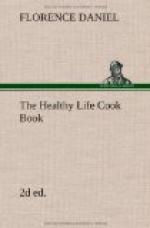1. COTTAGE CHEESE.
Allow the juice of two medium-sized lemons to 1 quart of milk. Put the milk and strained lemon-juice into an enamelled pan or fireproof casserole and place over a gas ring or oil stove with the flame turned very low. Warm the milk, but do not allow it to boil. When the milk has curdled properly the curds are collected together, forming an “island” surrounded by the whey, which should be a clear liquid. Lay a piece of cheese-cloth over a colander and pour into it the curds and whey. Gather together the edges of the cloth and hang up the curds to drain for at least thirty minutes. Then return to the colander (still in cloth) and put a small plate or saucer (with a weight on top) on the cheese. It should be left under pressure for at least one hour. This cheese will keep two days in cold weather, but must be made fresh every day in warm weather. The milk used should be some hours old, as quite new milk will not curdle. The juice from one lemon at a time should be put into the milk, as the staler the milk the less juice will be needed. Too much juice will prevent curdling as effectually as too little.
This cheese is greatly improved by the addition of fresh cream. Allow two tablespoonsful of cream to the cheese from one quart of milk. Mash the cheese with a fork and lightly beat the cream into it.
Note. Cheese-cloth, sometimes known as cream-cloth, may be bought at most large drapers’ shops at from 6d. to 8d. per yard. One yard cuts into four cloths large enough for straining the cheese from one quart of milk. Ordinary muslin is not so useful as it is liable to tear. Wash in warm water (no soap or soda), then scald well.
2. DRIED FRUITS.
These should be well washed in lukewarm water and examined for worms’ eggs, etc. Then cover with distilled water and let stand for 12 hours or until quite soft and swollen. Prunes, figs, and raisins are all nice treated in this way.
3. EGG CREAM.
2 tablespoons fresh cream, the white of 1 egg.
Put the white of egg on to a plate and beat to a stiff froth with the flat of a knife. (A palette knife is the best.) Then beat the cream into it. This makes a nourishing dressing for either vegetable salad or fruit salad. Especially suitable for invalids and persons of weak digestion.
4. PINE-KERNEL CHEESE.
Wash the kernels and dry well in a clean cloth. Spread out on the cloth and carefully pick over for bad kernels or bits of hard shell. Put through the macerator of the nut-butter mill. Well mix with the beaten pulp of a raw tomato (first plunge it into boiling water for a few minutes, after which the skin is easily removed). Raw carrot juice, or any other vegetable or fruit juice pulp may also be used.
5. RAW CARROT JUICE.
Well scrub a medium sized carrot and grate it to a pulp on an ordinary tinned bread grater. Put the pulp into a cheese cloth and squeeze out the juice into a cup.




